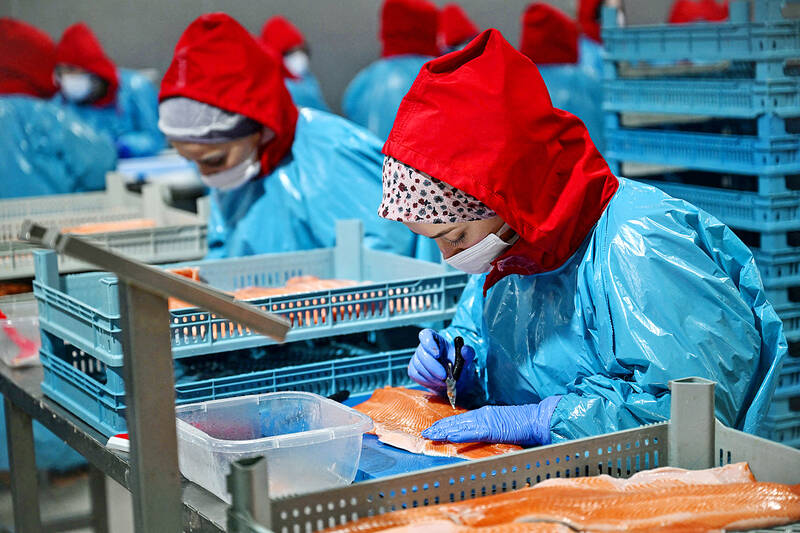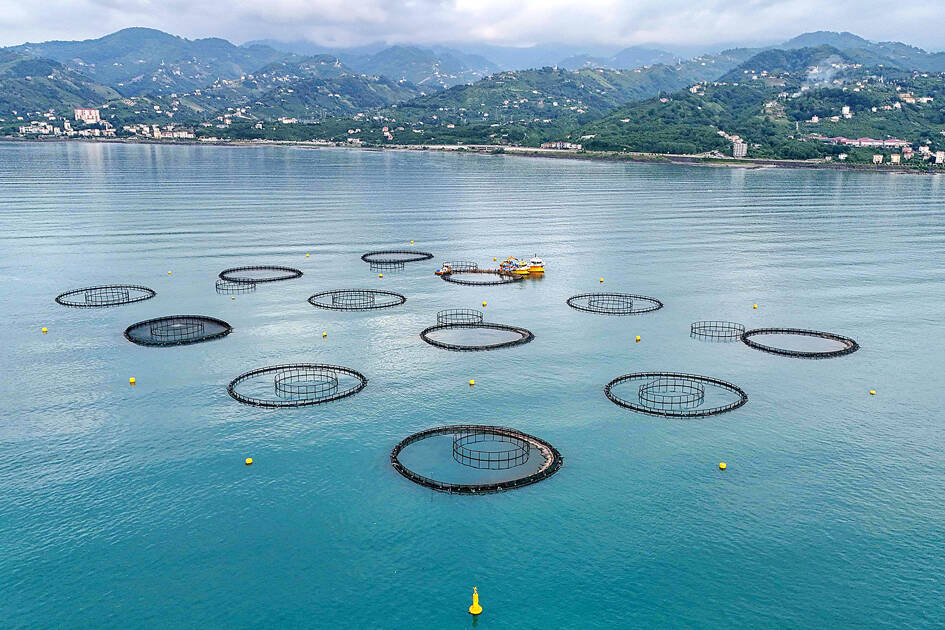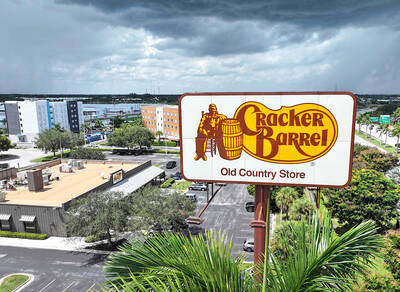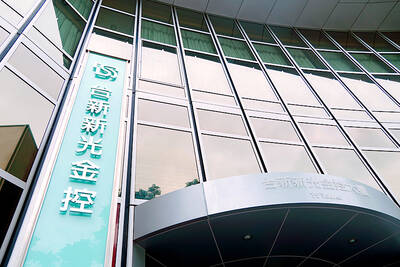Sitting in his spacious office with a view of the Black Sea, Tayfun Denizer smiles: His rainbow trout, raised in submerged cages, have made him a wealthy man. “Our exports surged from US$500,000 in 2017 to US$86 million last year, and this is just the beginning,” said Denizer, general manager of Polifish, one of the Black Sea’s main producers of what is marketed as “Turkish salmon.”
In its infancy just a decade ago, production of trout — which in Turkey is almost exclusively farmed for export — has exploded in line with the global demand for salmon, despite criticism of the intensive aquaculture required to farm it. Last year, the country exported more than 78,000 tonnes of trout raised in its cooler northern Black Sea waters, a figure 16 times higher than in 2018. It brought in about US$498 million for Turkish producers, a number set to increase but is still far from the US$12.8 billion netted by Norwegian salmon and trout giants in the same year. Russia, which banned Norwegian salmon in 2014 after the West imposed sanctions over its annexation of Crimea, accounts for 74.1 percent of “Turkish salmon” exports, followed by Vietnam with 6 percent, and then Belarus, Germany and Japan.
Stale Knudsen, an anthropologist at Norway’s Bergen University and a specialist on Black Sea fishing, said Russia offered “an available market that was easy to access, near Turkey.”

Photo: AFP
For him, the “spectacular success” of trout is also down to Turkey’s experience, and the technology used in farming sea bass and sea bream, a field in which it leads Europe.
Turkish producers have also benefited from the country’s large number of reservoirs where the fish are a raised for several months before being transferred to the Black Sea. There, the water temperature — which stays below 18°C between October and June — allows the fish to reach 2.5kg to 3kg by the time they are harvested. Last, but not least, is the price.
“Our salmon is about 15 to 20 percent cheaper than Norwegian salmon,” said Ismail Kobya, deputy general manager of Akerko, a sector heavyweight that mainly exports to Japan and Russia.

Photo: AFP
“The species may be different, but in terms of taste, color and flesh quality, our fish is superior to Norwegian salmon, according to our Japanese clients,” Kobya said at Akerko’s headquarters near the northeastern town of Trabzon, where a Turkish flag flies alongside those of Russia and Japan.
Inside, 100 or so employees in long blue waterproofs, green head coverings and rubber boots behead, gut, clean and debone trout that has an Aquaculture Stewardship Council (ASC) certification for responsible farming practices.
“Over the last two years, many Turkish producers have moved to get those certifications,” Knudsen said, adding that he does not believe such labels are always a guarantee of sustainability.
“I think the rationale behind that is not only to become more sustainable, but is more importantly a strategy to try to enter the European markets ... where the Norwegians have some kind of control,” he said.
In a study last year, researchers from a Turkish public institute raised concerns that “the rapid growth of the trout farming sector ... led to an uncontrolled decline in the survival rate” of the fish.
Pointing to the “spread of diseases” and “improper breeding management,” the researchers found that about 70 percent of the trout were dying prematurely.
Polifish, which also has an ASC certification, acknowledged a mortality rate of about 50 percent of their fish stocks, predominantly in the reservoirs.
“When the fish are small, their immune systems aren’t fully working,” its deputy general manager Talha Altun said.
Akerko for its part claims to have “reached a stage where we have almost no disease.”
“In our Black Sea cages, the mortality rate is lower than 5 percent, but these are farming operations, and anything can happen,” Kobya said.
Visible from the shore, the fish farms have attracted the wrath of local fishers worried about the cages, which have a 50m diameter, being set up where they cast their nets to catch anchovy, mackerel and bonito.
Mustafa Kuru, head of a local fishermen’s union, is a vocal opponent of a farming project that has been set up in his fishing zone just 70km from the Georgian border.
“The cages block the movement of the fish and what happens then? The fish start leaving the area,” he said, accusing the trout farmers of pumping chemicals into their “fake fish.”
He said a lack of fish stocks in the area had already forced two boats from his port to cast their nets much further afield — off the western coast of Africa.
“If the fish leave, our boats will end up going to rack and ruin in our ports,” he said.

On Tuesday, US President Donald Trump weighed in on a pressing national issue: The rebranding of a restaurant chain. Last week, Cracker Barrel, a Tennessee company whose nationwide locations lean heavily on a cozy, old-timey aesthetic — “rocking chairs on the porch, a warm fire in the hearth, peg games on the table” — announced it was updating its logo. Uncle Herschel, the man who once appeared next to the letters with a barrel, was gone. It sparked ire on the right, with Donald Trump Jr leading a charge against the rebranding: “WTF is wrong with Cracker Barrel?!” Later, Trump Sr weighed

HEADWINDS: Upfront investment is unavoidable in the merger, but cost savings would materialize over time, TS Financial Holding Co president Welch Lin said TS Financial Holding Co (台新新光金控) said it would take about two years before the benefits of its merger with Shin Kong Financial Holding Co (新光金控) become evident, as the group prioritizes the consolidation of its major subsidiaries. “The group’s priority is to complete the consolidation of different subsidiaries,” Welch Lin (林維俊), president of the nation’s fourth-largest financial conglomerate by assets, told reporters during its first earnings briefing since the merger took effect on July 24. The asset management units are scheduled to merge in November, followed by life insurance in January next year and securities operations in April, Lin said. Banking integration,

LOOPHOLES: The move is to end a break that was aiding foreign producers without any similar benefit for US manufacturers, the US Department of Commerce said US President Donald Trump’s administration would make it harder for Samsung Electronics Co and SK Hynix Inc to ship critical equipment to their chipmaking operations in China, dealing a potential blow to the companies’ production in the world’s largest semiconductor market. The US Department of Commerce in a notice published on Friday said that it was revoking waivers for Samsung and SK Hynix to use US technologies in their Chinese operations. The companies had been operating in China under regulations that allow them to import chipmaking equipment without applying for a new license each time. The move would revise what is known

Artificial intelligence (AI) chip designer Cambricon Technologies Corp (寒武紀科技) plunged almost 9 percent after warning investors about a doubling in its share price over just a month, a record gain that helped fuel a US$1 trillion Chinese market rally. Cambricon triggered the selloff with a Thursday filing in which it dispelled talk about nonexistent products in the pipeline, reminded investors it labors under US sanctions, and stressed the difficulties of ascending the technology ladder. The Shanghai-listed company’s stock dived by the most since April in early yesterday trading, while the market stood largely unchanged. The litany of warnings underscores growing scrutiny of